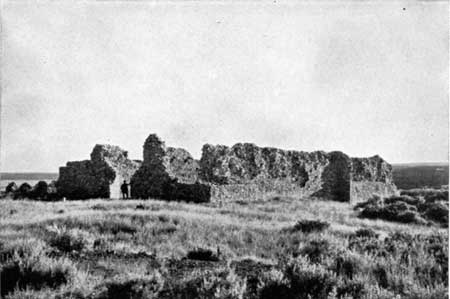![]()
MENU
|
Glimpses of Our National Monuments GRAN QUIVIRA NATIONAL MONUMENT |

Ruins of Gran Quivira Mission and some neighboring pueblos.
Photo by Grant.
Long recognized as one of the most important of the earliest Spanish church or mission ruins in the Southwest, the Gran Quivira was set aside as a national monument November 1, 1909, with an area of 160 acres. On November 25, 1919, the monument reservation was increased to 423.77 acres to protect the numerous Indian pueblo ruins situated near by.
The Gran Quivira stands upon an eminence of about 7,000 feet altitude, and commands a wide view of the surrounding country. The old church, of which only a few ruined walls remain, was established about the time the Pilgrim Fathers landed at Plymouth Rock. The "new" church was built about 1649, of blue-gray limestone laid in mud mortar in the form of a cross, with the short arms forming the side chapels. Its walls, in places nearly 40 feet high and 4 to 6 feet thick, roofless and ragged at the top, indicate a floor space of 4,978 feet. The extensive monastery and convents attached are plainly indicated by ruined walls. Excavations carried on by the School of American Research of Santa Fe, under permit from the Interior Department, during several years past, have resulted in cleaning up the ruins and revealing many interesting details of the Indian pueblos. Both churches are said to have been built by the women and children of the Piro Tribe of Indians.
These important ruins of dual interest can be reached by automobile from Mountainair, N. Mex., a station on the Santa Fe Railroad about 25 miles distant from the monument. It is a small town but has a good auto camp ground and well-stocked stores. There are several good roads to the monument. Going by one and returning by another, the visitor is afforded an opportunity to see much of the beautiful scenery of the adjacent country. In addition to the ruins of the Gran Quivira National Monument, the ruins of Cuarai and Abo, neighboring mission churches, may be reached from Mountainair. Cuarai, the largest, and Abo, the mother church, built of native red sandstone, present picturesque scenes among the cedar-lined hills.
The motorist traveling the National Old Trails road may visit this section by a side trip from Socorro, N. Mex. A few miles east of Socorro, which might have been transplanted bodily from Old Mexico, the Rio Grande is crossed and then after ascending a sharp grade the road continues across a level plain for 20 miles before coming into a mountain country with cedar forests and wonderful views. W. H. Smith, who lives at Gran Quivira, is custodian of the monument.
|
|
Last Modified: Thurs, Oct 19 2000 10:00:00 pm PDT
glimpses2/glimpses14.htm

 Top
Top